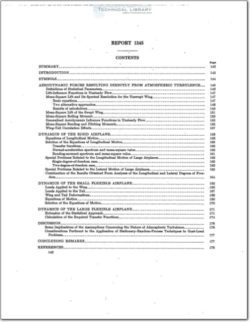NACA-Report-1345

- Version
- 124 Downloads
- 3.83 MB File Size
- 1 File Count
- December 4, 2015 Create Date
- December 4, 2015 Last Updated
National Advisory Committee for Aeronautics, Report - The Response of an Airplane to Random Atmospheric Disturbances

The statistical approach to the gust-load problem which con—
sists in considering flight through turbulent air to be a stationary
random process is eatended by including the efiect of lateral
variation of the instantaneous gust intensity on the aerodynamic
forces. The forces obtained in this manner are used in dynamic
analyses of rigid and flmble airplanes free to move vertically,
in pitch, and in roll. The efiect of the interaction of longi-
tudinal, normal, and lateral gusts on the wing stresses is also
considered.
The method of analyzing the rigid-body motions is similar
to that used for analyses of the dynamic stability of airplanes,
in that the equations of motion are referred to stability aces
and expressed in terms of conventional stability derivatives.
The method of analyzing the dynamic ejects of structural
flexibility consists in an extension of a numerical-integration
approach to the static aeroelastic problem and is in a form
which ofiers the possibility of calculating divergence and flutter
speeds with relatively little additional efl'ort.
The mean-square values, correlation functions, and power
spectra of some of the aerodynamic forces required in this type
of analysis are calculated for one special correlation function
of the atmospheric turbulence. It is shown, for instance, that
if the span is relatively large compared with the integral scale
of turbulence, the mean—square lift and root bending moment
directly due to the gust are substantially reduced when the
differences in instantaneous intensity of the turbulence along
the span are taken into account. However, if the motions of
the airplane are taken into account the mean-square root bend-
ing moment may be increased as a result of these dizferences.
Also, the mean-square pitching moment is shown to be sub-
stantially increased if the tail length is relatively large compared
with the scale of turbulence. Finally, the wing stresses due to
longitudinal, normal, and lateral gusts are shown to be statis-
tically independent under certain conditions.
| File | Action |
|---|---|
| NACA-Report-1345 The Response of an Airplane to Random Atmospheric Disturbances | Download |

Comment On This Post